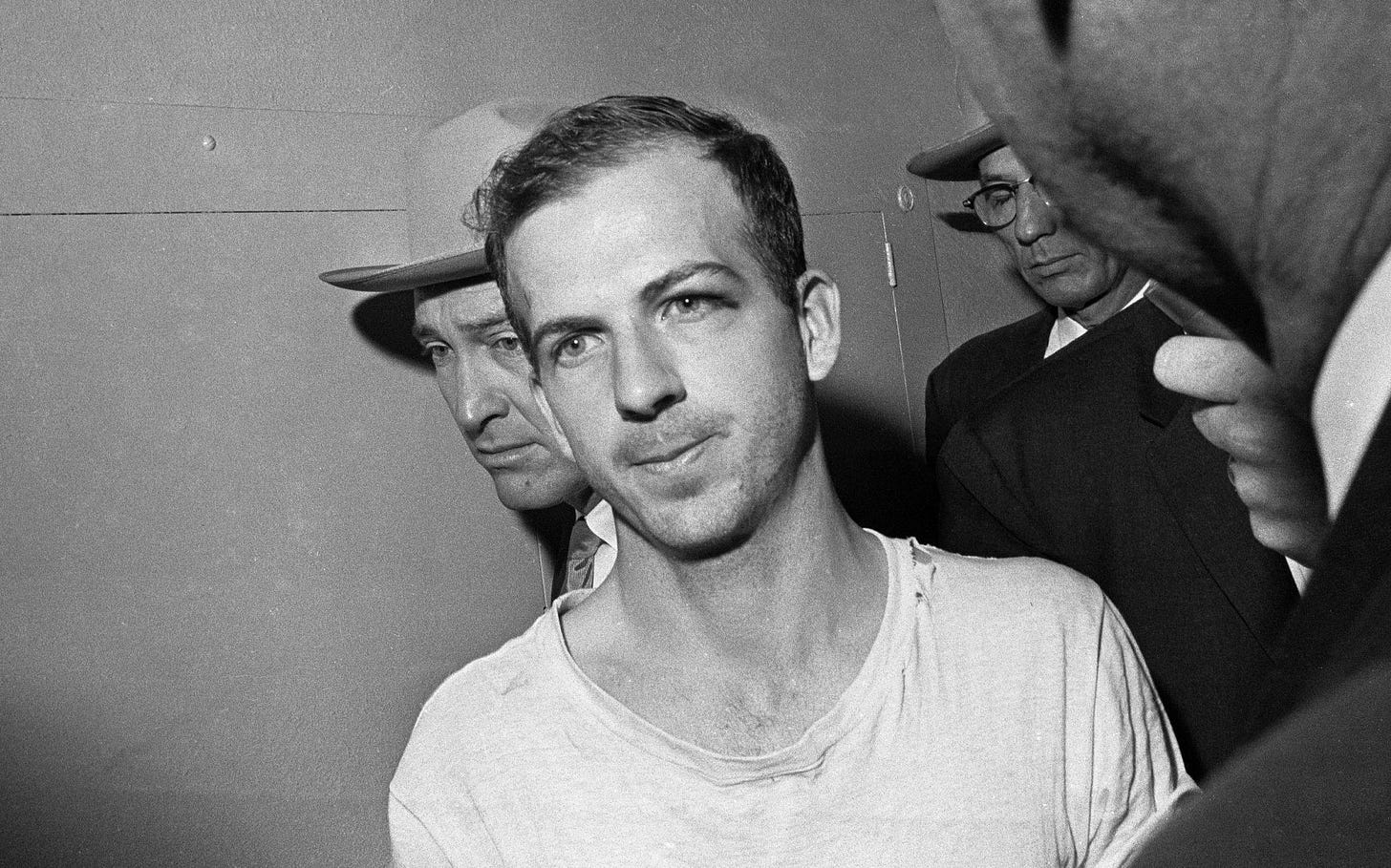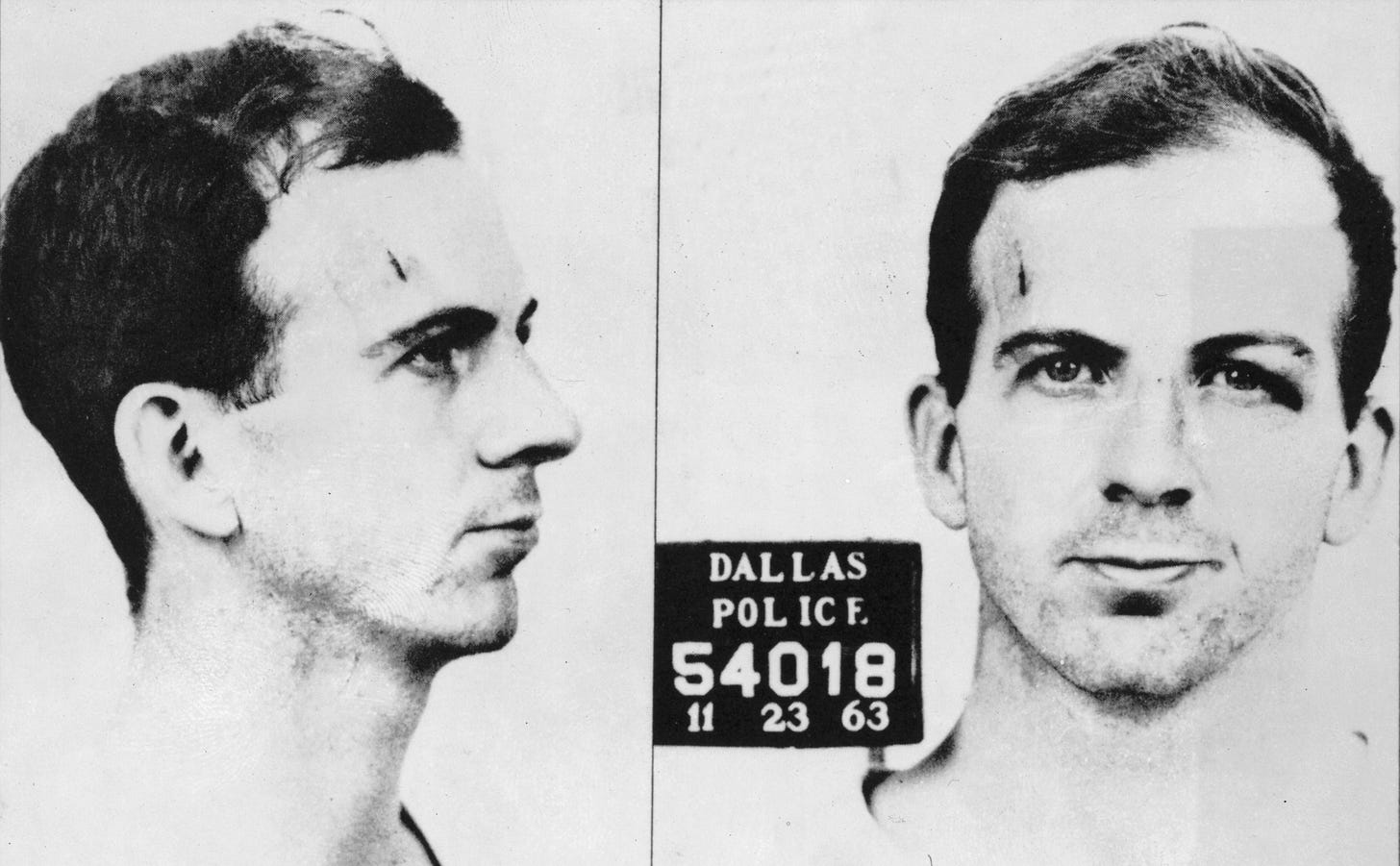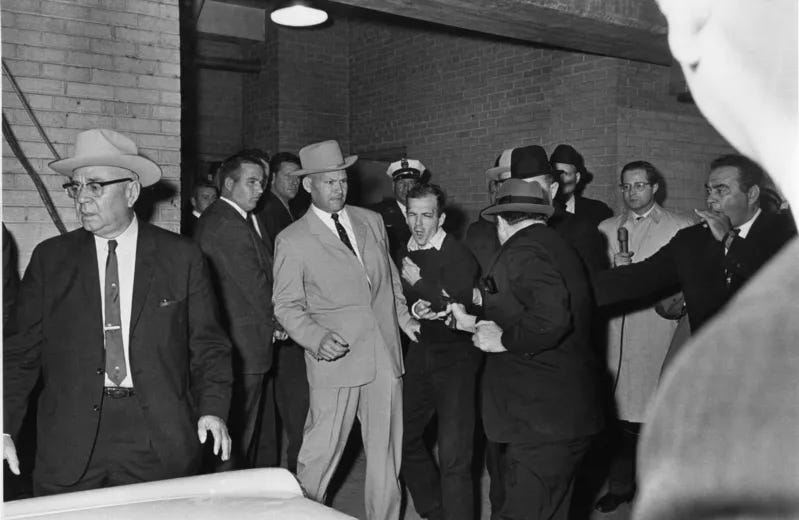The exact origin for the adage “history is written by the victors” is as confusing and oftentimes as undefinable as the true answer for the question of who killed President Kennedy. It is an irony shaped by the fact that the victors in this case, those responsible for the framework of the JFK assassination plot, actually did write the history that followed the murder in Dallas. But the findings of The Warren Commission were not copied and pasted into the history books for the schoolchildren of the United States; instead, like other historical incidents, they were simplified into a rhythmic format modeled after the likes of George Washington never telling a lie and chopping down a cherry tree.
Teachers for developing, malleable, and absorbing young minds do not teach myths or magic as applied to the actual history of the United States and the world. What they do teach is a combination of facts and folklore that make the subject matter easily digestible and easily moved on from as each school year evolves. Folklorish memory devices like those attributed to Washington are embedded into the brains of students and never forgotten: they can be regurgitated ad infinitum. Thus, when the JFK assassination is briefly studied in history classrooms, the only finite conclusion offered is that Lee Harvey Oswald committed the crime.
And, for the rest of their lives, the overwhelming majority of American citizens will recite this as fact, and not as folklore, because that is what they were taught by beloved and respected teachers at their schools. It is a form of programming that is not the fault of school districts, nor of the teachers themselves, but more the necessary reality of covering a wide range of history topics in a single year of study. The affiliation of Lee Harvey Oswald to JFK for impressionable children is no different from Eli Whitney to the cotton gin or Jackie Robinson to breaking the color barrier in professional baseball. It is accepted as fact without any debate. But, unlike the cases with Messrs. Whitney and Robinson, it is hardly fact at all.
The beauty of the term “conspiracy theory,” brilliantly coined by JFK plotter Allen Dulles, is that it provides an instantaneous negative response from adults who were unknowingly indoctrinated as youths to adhere to the simplistic Oswald narrative. As mentioned previously, that a term hatched by a member of the Warren Commission to discredit doubters of the report itself is mind-boggling, perhaps even mind-numbing, when it is understood that several of the crime’s masterminds were tasked with investigating the very crime they committed! Conspiracy theories are routinely discounted by members of the general public who have been told throughout their lives that a single gunman shot JFK in Dallas. And it is not the general public’s fault: who amongst us has time to read and evaluate (and question) the 888 pages of the report? Those that do question its integrity and go public with their findings are, typically, discredited as conspiracy theorists.
Perhaps the greatest hindrance to solving the crime is the failure of researchers to work together, as touched upon previously in this brief, to develop philosophical and mathematical approaches to the facts that have been concretely determined in conjunction with the further investigations to be done regarding the elements that remain unsolved. The lack of alignment for arguments from one segment of the researcher population with other JFK assassination sleuths further bolsters their findings as conspiracy theories. It is too confusing for members of the general public, no matter their intelligence quotients or levels of education, to parse the various conclusions and emote a reasonable solution. And in the case of defining Lee Harvey Oswald, the competing suppositions from self-described, huckster-ish experts make it apparent that many are, indeed, the same conspiracy theorists they so deeply abhor.
We cannot have it both ways from assassination researchers with Lee Harvey Oswald.
We cannot have him be a ne’er-do-well loner who wished to make a name for himself in a sociopathic manner and also be a cool-headed undercover operative who received Russian language instruction in the Marine Corps. We cannot have him be described as a simplistic rube by single-gunman theorists and also be recounted by those believing in a massive plot as connected to the highest echelons of the intelligence services of the United States. But these are just some of the obtuse examples that the experts from JFK research extremes have provided for us in the past six decades regarding Oswald.
How can there be such disparities about a single person’s character and activities, in a rather short lifespan, if these novelists and documentarians are performing legitimate research and due diligence?
Experts profile serial killers. Journalists offer definitive histories for celebrities and athletes. Yet, we have competing narratives about the alleged perpetrator for one of history’s greatest crimes who never even made his twenty-fifth birthday?
Lee Harvey Oswald was murdered by Jack Ruby in the basement garage of the Dallas Police Department headquarters just over a month into his 24th year, yet his purported activities in the seven years since he joined the Marine Corps to his death—for those who fashion him as an asset for both the CIA and FBI—take him on a James Bond-like rollercoaster of intrigue. For those who opt to chronicle him as merely a simpleton, however, those seven years were a bored and lazy journey of disillusionment, loneliness, and despair.
There is so much that is unknown about Lee Harvey Oswald, but here is what can be proved based on facts:
As a teenager, Oswald was in the Civil Air Patrol in Louisiana with David Ferrie.
In her book about David Ferrie, researcher Judyth Vary Baker linked him to Carlos Marcello in New Orleans.
Oswald was arrested in New Orleans on August 9, 1963 for an altercation on the corner of Canal and St. Charles streets near the French Quarter.
The fracas developed because Oswald had been distributing leaflets supporting Fidel Castro in front of a store owned by anti-Castro activist Carlos Bringuier, head of the staunchly anti-Castro Student Revolutionary Directorate. Four days earlier, Oswald had entered Bringuier’s business claiming he was against Castro and communism. Oswald stated he was trained in guerilla warfare in the Marine Corps, and offered to train exiled Cubans in the fight against Castro. Bringuier refused Oswald’s offer, and instead offered Oswald anti-Castro literature. The next day, Oswald returned to the clothing store to leave Bringuier his copy of “Guidebook for Marines,” a reference book on weapons, tactics, and other military information.
Oswald was recorded handing out pro-Castro leaflets by WDSU-TV in New Orleans (August 9, 1963), was interviewed by the station shorty after his arrest, then had two radio appearances a week later including one in which he debated Bringuier, his combatant a week earlier, and Edward Butler, head of an anti-Communist propaganda organization called the Information Council of the Americas.
On August 17, 1963, Oswald accepted an invitation to discuss his work for the Fair Play for Cuba Committee (FPCC), a Communist, pro-Castro group. He had made the local TV news in New Orleans for distributing FPCC leaflets and getting into a confrontation with anti-Castro Cubans. In this 35-minute interview you'll hear Oswald talking about his role as "secretary" for the New Orleans branch of FPCC, offering his views on communism and capitalism, and defending Castro's Cuba.
Oswald's second radio appearance, four days later, is more famous. In this one, Oswald debated Edward Butler, head of an anti-Communist propaganda organization, and Carlos Bringuier, the leader of an anti-Castro group. Butler had done some background research on Oswald and attacked him on his defection to Russia. At the end of the 20-minute debate, Oswald appeared very upset. The debate seemed to have humiliated him and ended his campaign for Castro on the streets of New Orleans.
Does it seem reasonable with these three proven facts that Lee Harvey Oswald was simply a misguided young man searching for an identity through political affiliations, or rather that he was engaged in deliberate, high-profile operations as directed by his intelligence agency handlers to establish a public identity for himself?
It is rather odd—and quite convenient—that the person accused of being the lone murderer for JFK would have multiple media interviews about his pro-Castro stance just three months before the assassination in Dallas. And that he ever bothered to act as though he had been humiliated. Lying, after all, is the tradecraft for intelligence agents. Oswald’s demeanor in relation to pro-Castro activities is especially disconcerting because of his established ties to CIA operatives, and rabid anti-communists, David Ferrie, Guy Banister, and Clay Shaw in the mere 153 days he spent in New Orleans prior to his move to Dallas.
While it can always be alleged that where there is smoke, there is fire, it can also be alleged that people are, indeed, the company they keep.
Were Oswald to actually be an active communist, an active supporter of Fidel Castro, and also willing to hand out anti-American foreign policy leaflets on street corners in New Orleans during the height of the Cold War—less than a year removed from the Cuban Missile Crisis—it is extremely improbable that fervent anti-Castro adherents, including the former leader of his Civil Air Patrol unit a decade earlier in Ferrie, would cavort with him. The Ferrie-Bannister connection is undeniable: they both worked for G. Wray Gill, a lawyer, to try to help block Carlos Marcello's deportation to Guatemala. Additionally, Jim Garrison—the famed district attorney for New Orleans immortalized in the often factually incorrect movie JFK—was convinced that New Orleans businessman Clay Shaw was a leader of the assassination plot. In an application for a warrant to search Shaw's French Quarter home, Ferrie was listed as a guest at meetings there, along with Oswald, to plan the conspiracy.
Garrison’s indictment and prosecution of Shaw, obviously, resulted in failure and a verdict of innocent for the latter—unlike the legal decision with E. Howard Hunt and The Spotlight.
Let us examine another set of evidence in the form of a timeline regarding Oswald’s time in the Soviet Union.
On September 11, 1959, he was granted a hardship discharge from the Marine Corps due to his mother’s health issues. Oswald’s rank at the time was Private First Class (E-2); the pay scale in 1959 for his enlisted rank and time in service was $108 per month.
In October 1959, Oswald traveled to the Soviet Union—purportedly at his own expense after being discharged from the Marine Corps as a Private First Class—and applied for citizenship. His application was rejected before, on the eve of his deportation, he attempted a suicide attempt (October 21, 1959).
On October 31, 1959, Oswald visited the US Embassy in Moscow to renounce his American citizenship.
The following month, Soviet officials directed Oswald to the city of Minsk, assigned him a job, and arranged accommodations at a studio apartment.
In March 1960, he met Marina Prusakova. They were married in June, just three months later. Prior to the nuptials, Marina had been living in Minsk with her uncle, a colonel in the Russian Interior Ministry (MVD) security service. At that time, the agency—which was a mixture of a national police force and military intelligence—carried out several functions, from running large parts of the Gulag (a system of Soviet labor camps and accompanying detention and transit camps and prisons) to serving as an internal security force.
Oswald and his wife, plus their four-month-old child June, left the Soviet Union and moved to Dallas, Texas on June 1, 1962.
We are, thus, asked again to apply Aristotelian logic and the concepts of probability in accordance with the law of large numbers. And what is the law of large numbers, exactly?
In probability and statistics, it states that as a sample size grows, its mean gets closer to the average of the whole population. In the 16th century, mathematician Gerolama Cardano recognized the Law of Large Numbers but never proved it. In 1713, Swiss mathematician Jakob Bernoulli proved this theorem in his book, Ars Conjectandi. It was later refined by other noted mathematicians, such as Pafnuty Chebyshev, founder of the St. Petersburg mathematical school.
The fact that Chebyshev, like Alexandre and Alick Brun de Saint-Hippolyte, were all associated—whether by employment or birth—with St. Petersburg in Russia has nothing at all to do with the JFK assassination plot, but does serve as a bit of contextual seasoning and coincidental humor for our studies.
In the case of Lee Harvey Oswald, the only reasonable depiction for historians must be centered around his likely status as an intelligence asset for the United States. What makes the most sense, probability-wise, via the Law of Large Numbers?
Has there ever been another E-2 in the history of the armed forces for the United States who has defected to a foreign nation, after traveling a great distance at his own expense despite his previously trifling military salary, only to have that nation welcome him with a job and residence after nearly deporting him? Even the most untried writers of fictional novels concerning clandestine affairs, and their accompanying audiences of similar novices in the field, should be able to discern—based on Oswald’s timeline in the Soviet Union and New Orleans—that he was not the marginalized loner that historians who are single-gunman proponents sketch him to be. Yet, we must continue to ask another simple question: why do accomplished JFK assassination researchers still possess this mindset when there is such a preponderance of evidence to the contrary?
There is not a single person, alive or dead, who will ever know the entire truth about Lee Harvey Oswald or any/all of the JFK plot conspirators. Assassination plans were not saved on a laptop, detailed notes were not kept in a diary, and there are no smoking-gun text messages. There are no recorded Zoom meetings or phone conversations, either. This operation was undertaken by face-to-face meetings that involved brilliant men with overlapping goals for political power and profit. The pretexts of anti-communist rhetoric, of ridding the Western Hemisphere of Fidel Castro, and of halting communist expansion in Southeast Asia were employed to secure those two objectives. Concurrently, of course, were the multiple interests of the organized crime enterprises led by Marcello, Giancana, and Trafficante. And Lee Harvey Oswald, he of the intelligence background and connections, was unwittingly employed to serve as the recognizable patsy for the cover-up of a false-flag operation.
The term “false-flag” goes back at least to the age of piracy, when pirate ships would fly a deceptive flag (of a friendly or neutral state) to lure their prey within striking distance before running up the Jolly Roger and attacking. In modern usage, a false-flag operation is a deliberately planned ruse to make it seem like a state has been attacked, thereby justifying retaliatory military operations against the purported offender.
Basically, Oswald was duped into believing he was part of one particular false-flag operation—the infiltration of communist groups in New Orleans and beyond—when, in fact, he was the scapegoat to be used in an actual operation. As our nation’s history books describe in the simplest of terms, a disenfranchised radical named Lee Harvey Oswald, who had once defected to Russia and handed out pro-Castro leaflets in New Orleans, shot and killed President Kennedy in Dallas on November 22, 1963. After all, that is the take of the renowned and quite wealthy assassination expert Gerald Posner in his book, Case Closed. It is also the position of the renowned and also quite wealthy Gus Russo, another single-gunman true believer, in his book Live By The Sword: The Secret War Against Castro and The Death of JFK.
Despite the fantastical claims by the two authors that Oswald was the only person to shoot President Kennedy, even Posner and Russo have their differences: the former believes Oswald (and Ruby for that matter) acted independently, while the latter believes Oswald to be a part of a conspiracy of pro-Castro actors. This differentiation is a further subset, then, of the conflicts for single-gunman theorists and multiple-gunmen theorists. There are still rather striking polarities within the ranks of these two respective camps almost sixty years after the murder.
How can we ever get close to reaching a provable conclusion regarding this crime when even the foremost of authorities on the subject seek literary fame and profits over collaboration?
The greater number of JFK assassination experts are not far removed from the many opportunists who hawked t-shirts outside of the courthouse during the trial of O.J. Simpson.
And they are certainly not the communists of the past they claim to know so much about.







